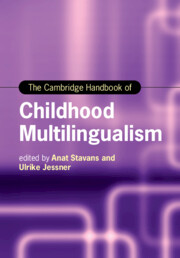Book contents
- The Cambridge Handbook of Childhood Multilingualism
- Cambridge Handbooks in Language and Linguistics
- The Cambridge Handbook of Childhood Multilingualism
- Copyright page
- Contents
- Figures
- Tables
- About the Editors
- Contributors
- Acknowledgments
- Multilingualism Is Not Bilingualism +1: An Introduction
- Part One Becoming and Being a Multilingual Child
- 1 Infant Bi- and Multilingual Development
- 2 The Development of Childhood Multilingualism in Languages of Different Modalities
- 3 Multilingualism in Early Childhood: The Role of the Input
- 4 Multilingual Education in Formal Schooling: Conceptual Shifts in Theory, Policy and Practice
- Part Two Cognition and Faculties in Multilinguals
- Part Three Family Language Policy
- Part Four Language(s) and Literacy of Multilingual Children through Schooling
- Part Five Socialization in Childhood Multilingualism
- Part Six Multilingual Children’s Landscape
- Subject Index
- Country Index
- Language Index
- References
3 - Multilingualism in Early Childhood: The Role of the Input
from Part One - Becoming and Being a Multilingual Child
Published online by Cambridge University Press: 18 August 2022
- The Cambridge Handbook of Childhood Multilingualism
- Cambridge Handbooks in Language and Linguistics
- The Cambridge Handbook of Childhood Multilingualism
- Copyright page
- Contents
- Figures
- Tables
- About the Editors
- Contributors
- Acknowledgments
- Multilingualism Is Not Bilingualism +1: An Introduction
- Part One Becoming and Being a Multilingual Child
- 1 Infant Bi- and Multilingual Development
- 2 The Development of Childhood Multilingualism in Languages of Different Modalities
- 3 Multilingualism in Early Childhood: The Role of the Input
- 4 Multilingual Education in Formal Schooling: Conceptual Shifts in Theory, Policy and Practice
- Part Two Cognition and Faculties in Multilinguals
- Part Three Family Language Policy
- Part Four Language(s) and Literacy of Multilingual Children through Schooling
- Part Five Socialization in Childhood Multilingualism
- Part Six Multilingual Children’s Landscape
- Subject Index
- Country Index
- Language Index
- References
Summary
This chapter takes a critical approach to what we know about the role of the input in multilingual development in early childhood. We include a historical background on competing theoretical approaches to language acquisition in which we argue that usage-based approaches gained traction through the attention paid to input in multilingual acquisition studies. However, in reviewing such studies we draw attention to the limitations of their focus on parental rather than community input. We also draw attention to the need to go beyond the binary distinction of simultaneous and successive acquisition and take into account more fully the child’s age of acquisition in relation to the development of specific areas of language. We review the findings on the link between code-switching or mixing in the input and child productions, pointing out the range of different methodological approaches in identifying mixing. We advocate a more child-centred approach in which the morphosyntactic frame of the child’s utterance is taken into account, and illustrate this with our own study. Finally we argue that future studies should include full ethnographic information about the community setting in which multilingual acquisition takes place.
- Type
- Chapter
- Information
- The Cambridge Handbook of Childhood Multilingualism , pp. 58 - 81Publisher: Cambridge University PressPrint publication year: 2022
References
- 2
- Cited by

